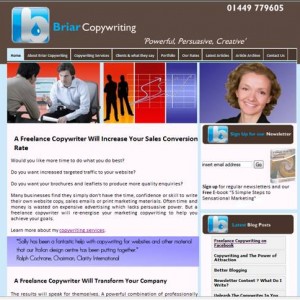Entries Tagged 'copywriting tips' ↓
June 13th, 2011 — blog, blogging, blogging for business, copywriting tips
 You’re ready to take the plunge.
You’re ready to take the plunge.
You’ve set up your blog and eager to get your first post written so you can hit the ‘publish’ button.
But how long will your initial enthusiasm last?
All too often people dive into blogging without really understanding what it takes to be a successful blogger.
There are loads of stories banded about of people who make a living just from blogging. But if it was that easy we’d all be doing it.
Creating and sustaining a popular blog is hard work – are you ready for a life long commitment?
Blogging stamina
Here are 5 things you have to have if you want to succeed. It’s not an exhaustive list but designed to give you a taster of what you could be taking on.
1. Time
There are bloggers out there making money from their blogs. But it didn’t happen overnight. If you want to generate an income from your blog it’s going to take a lot of time and hard work. Your dedication will be severely tested and only the truly committed will make it.
2. Passion
Running a blog is non-stop.
You have to be totally in love with your subject to pull off a successful and lasting blog relationship. You will have to write year after year about your subject – can you generate enough ideas to pull that off?
3. Traffic
Many people are completely hung up on the number of visitors they get to their blog. But the true measure of a successful blog is the number of visitors who stay, come back, interact with you through comments and share your content with others.
4. Promote
Just because you have a blog and post to it regularly doesn’t mean people will find you.
To grow your readership you’ll have to promote your blog continuously through outlets such as Twitter and Facebook.
5. Plan
Before you begin you have to have a plan:
- Why are you blogging?
- What do you want to achieve?
- What will your posting schedule be?
- What will you blog about?
As you can see, having a blog is a long term commitment. How do you manage yours? Why not share your blogging experiences by adding a comment below.
June 10th, 2011 — copywriting tips, marketing, Press releases
 As a business owner I’m guessing you spend a fair amount of your marketing budget on your online marketing (and off line).
As a business owner I’m guessing you spend a fair amount of your marketing budget on your online marketing (and off line).
You have website copy to keep up to date, email marketing to do, blogs and articles to write not to mention the brochure you need to revamp.
All of that takes money but there is something out there that can generate a shed load of free publicity.
Don’t forget your PR
Most marketers have lost faith in print marketing and advertising. But you shouldn’t ignore the power of great press coverage.
Whether it’s in the form of an interview, quote, feature or editorial, being seen in the ‘right’ magazines and papers can pay dividends.
And here’s why…
1. Cheap
Getting a press release professionally written is an awful lot cheaper than paying for advertising space. Once it’s submitted and accepted you could end up with a page in a magazine or on a blog/website that’s all about you – pretty powerful stuff.
2. Credible
The public are fairly sceptical about marketing and can be resistant to anything that is obviously trying to sell to them. But good press coverage (such as a success story about your company or customer case study) is far more believable.
3. Connect
Adverts are impersonal. A good news story will personalise your company in your readers’ eyes and so make a connection with them.
4. SEO
Submitting press releases to online sites and blogs will help generate back links to your website and help your SEO.
5. Recycle
You can get a lot of mileage out of a press release. The content can be reused and turned into blogs and articles. It could be picked up by other publications and lead to other features and articles. The possibilities are endless.
So whatever you do, don’t forget to make sure your marketing strategy includes PR.
Have you had any PR successes you can share with us? If so leave a comment and let us know what happened and how it helped your business.
June 8th, 2011 — copywriting tips, website copywriter, website copywriting
 Take a look at your website.
Take a look at your website.
Have a quick read of it – have you we’d everywhere?
Far too many company websites out there are suffering from a nasty bout of incontinence. Their website copy is littered with we.
“We create wonderful furniture…”
“We take customer service seriously…”
“We have been working in this industry for 40 years…”
Do I look as though I care about any of that?
No!
As a customer looking through your website, I couldn’t give a toss about what your company’s achieved, how big your sales team is or how long you’ve been in business.
There’s only one thing I want to know and that’s what will your product/service do for me?
I want you to talk to me and tell me you’re going to make my life better. I want to hear about how you’re going to save me time, make me more glamorous or save me loads of money.
But to do that you’ve got to ditch the ‘we’ and replace it with ‘you’.
Website copywriting must address your reader at all times and that means writing in the second person.
Want an example?
OK, take a look at this text which I’ve taken from my website:
A Freelance Copywriter Will Increase Your Sales Conversion Rate
Would you like more time to do what you do best?
Do you want increased targeted traffic to your website?
Do you want your brochures and leaflets to produce more quality enquiries?
Many businesses find they simply don’t have the time, confidence or skill to write their own website copy, sales emails or print marketing materials. Often time and money is wasted on expensive advertising which lacks persuasive power. But a freelance copywriter will re-energise your marketing copywriting to help you achieve your goals.
See what I mean? All the way through the text I’m talking to the reader – no ‘we’ anywhere.
Granted I’m a website copywriter (just one of the many copywriting services I offer), but this is an effect that is simple to create.
When composing your web copy:
- Forget about your company
- Write as if you were talking to a customer who was standing in front of you
- Resist the urge to type ‘we’
Using the second person will help you make a connection with your reader. Make them feel as though they are the most important person in the world.
June 6th, 2011 — copywriting tips, Link Building, search engine optimisation, seo, SEO copywriter
Getting great rankings isn’t just about the structure of your website and its copy. Obviously they both have a major influence but there is also a third element that must be present.
Frequently businesses will fork out for a great website and hire a professional SEO copywriter to ensure their copy is SEO friendly, engaging and customer focused. But once their site is live they just sit back and wait.
That’s when the web designer or copywriter gets a phone call asking why their website isn’t on the front page of Google.
First it takes time for that to happen (it’s not going to be an overnight occurrence), secondly your SEO strategy does not end once your site has gone live. That’s just the beginning.
Make Google love you
Probably the most important aspect of SEO is link building.
They are important because they show Google the relevancy and authority of your website. So the more you have the better.
But that doesn’t mean any old link will do.
The link building process has to be done over time and consistently. But don’t be tempted into taking shortcuts by using link farms or paid link networks. The links coming into your site must be genuine and relevant to your site. Google does check the quality of your links so if they’re not genuine and relevant you could end up with a hefty Google penalty.
Here’s what Google’s Webmaster Tools has to say on the matter:
Link schemes
Your site’s ranking in Google search results is partly based on analysis of those sites that link to you. The quantity, quality, and relevance of links count towards your rating. The sites that link to you can provide context about the subject matter of your site, and can indicate its quality and popularity. However, some webmasters engage in link exchange schemes and build partner pages exclusively for the sake of cross-linking, disregarding the quality of the links, the sources, and the long-term impact it will have on their sites. This is in violation of Google’s Webmaster Guidelines and can negatively impact your site’s ranking in search results. Examples of link schemes can include:
- Links intended to manipulate PageRank
- Links to web spammers or bad neighborhoods on the web
- Excessive reciprocal links or excessive link exchanging (“Link to me and I’ll link to you.”)
- Buying or selling links that pass PageRank
The best way to get other sites to create relevant links to yours is to create unique, relevant content that can quickly gain popularity in the Internet community. The more useful content you have, the greater the chances someone else will find that content valuable to their readers and link to it. Before making any single decision, you should ask yourself the question: Is this going to be beneficial for my page’s visitors?
It is not only the number of links you have pointing to your site that matters, but also the quality and relevance of those links. Creating good content pays off: Links are usually editorial votes given by choice, and the buzzing blogger community can be an excellent place to generate interest.
Once you’ve made your changes and are confident that your site no longer violates our guidelines, submit your site for reconsideration.
Source: Google Webmaster Central
Back link analysis
Your Google rankings will constantly go up and down as your competitors vie for the top spot. Constant link building will help you in the rankings battle, so making use of a back link analysis tool (such as SEO Books free tool) will allow you to check out not only where your links are coming from but also who is linking to your competitors.
Links through content
Another way to grow your links is through content. Writing relevant articles which link back to your website should be part of your SEO strategy.
Plus look for guest blogging opportunities and again link back to your site within your blog post.
Generating links should be seen as part of your marketing strategy. Take the ‘one thing a week’ approach and alternate between creating directory listings, writing and submitting articles and generating blog posts.
Breaking down your link building into manageable chunks in this way will ensure the process is continuous.
What strategies do you have for link building? Why not leave a comment and share your experiences.
June 1st, 2011 — copywriter, copywriting, copywriting tips, marketing, social media, website copywriter, website copywriting, website design
 As a business owner you want and need customers.
As a business owner you want and need customers.
Ideally those customers will be of the happy variety that come back time and time again and bring all their friends along too.
But how do you make sure your website and customer service can generate that level of customer satisfaction?
When shopping online, people want speed, simplicity and a warm and fuzzy feeling once they’ve completed their purchase.
Other than tracking them all down and giving them a hug, how can you achieve this through your website?
Here are a few ideas.
Speeding it up
Your customers want to reach your site, find their product, and add it to their shopping basket and pay. So making that process as slick and fast as possible is essential.
Let’s start at the beginning.
1. Loading your site
Your website must load as quickly as possible because your customers aren’t going to hang around waiting for you. By reviewing all the images on your site and compressing them you’ll shorten the load time.
2. Payment
Jumping to the final stage of the buying process, you’ll need to offer a range of payment choices. Paypal is a must as it’s fast, safe and very convenient.
Simplicity
A mistake made by many companies is that their website is full of images, graphics, text and adverts making it impossible for the reader to navigate because there’s so much going on they don’t know which way to turn.
Keeping your site simple eases navigation and understanding.
3. Review your text
How readable is your text? By slightly increasing your font size you’ll make your site more readable.
4. White space
There’s nothing worse than a website that contains masses of solid text. You might think it conveys to the reader everything they need to know but that’s rather counterproductive because they won’t read it.
If you want someone to look at your site, its content has to be attractive. You can achieve this by:
- Shortening your paragraphs (5 lines or less)
- Add bulleted lists to highlight benefits
- Use sub headings
- Use images
But make sure you mix all these elements up to add variety and interest to your page.
Warm and fuzzy
This is probably the hardest one to achieve. How do you give them that warm and fuzzy feeling?
5. Social media
I’m assuming you’re using social media within your marketing strategy (if not why not?) so make sure you monitor your Twitter stream and Facebook page so when customers ask questions about your products you respond to them quickly.
The other site of this is you’ll also be aware of compliments that come through your social media accounts (because you’ll be monitoring them) so make sure you say thank you.
There’s also a possibility that you’ll also get the off negative comment but because you’re monitoring your social media accounts you’ll be able to instantly make contact with the customer and put the situation right.
6. Get personal and obvious
Many companies get so wrapped up in looking professional they end up projecting a cold and impersonal image.
Customers want to buy from someone they like so by creating a website that shows your personality rather than a stale corporate image will get you noticed.
Being obvious doesn’t mean plastering your website with “buy now” in big red letters. Obvious means making your navigation simple to use so anyone can find their way to the page they want. There’s nothing worse than finding a website that sells the product you want but being unable to fathom out how to buy it.
7. Be chatty
When creating the copy on your website please don’t ‘we’ all over it.
Now sure what I mean? Well it’s quite simple. Take a look at your website and count how many times the word ‘we’ appears. In an ideal world there won’t be any.
Your customer couldn’t give two hoots about you; they want to know what you are going to do for them. So review your content and change the focus. If you’re not sure how to do that, find a professional copywriter who can do it for you. You’d be amazed at the difference it will make. You will instantly become:
- Approachable
- Customer-orientated
- Trustworthy
So there you go, 7 simple but effective ways you can change your website’s effectiveness overnight.
Try them out and come back and tell us how you got on. Do you have any other ideas? If so leave a comment below.
 You’re ready to take the plunge.
You’re ready to take the plunge. As a business owner I’m guessing you spend a fair amount of your marketing budget on your online marketing (and off line).
As a business owner I’m guessing you spend a fair amount of your marketing budget on your online marketing (and off line). Take a look at your website.
Take a look at your website.
 As a business owner you want and need customers.
As a business owner you want and need customers.




